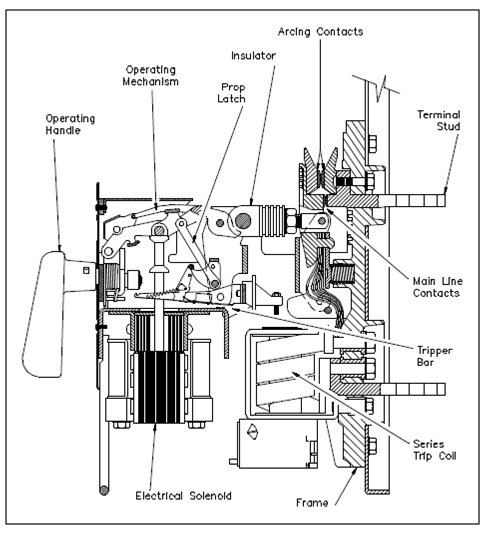Large Air Circuit Breaker:
A circuit breaker will automatically trip while the current by it exceeds a pre-determined value. In lower current ratings, automatic tripping of the circuit breaker is accomplished through use of thermal tripping devices. Thermal trip components consist of a bimetallic element which could be calibrated so in which the heat from normal current by it does not cause it to deflect. An abnormally high current that could be caused through a short circuit or overload condition will cause the element to deflect and trip the linkage which contains the circuit breaker shut. A circuit breaker will then be opened through spring action. This bimetallic element, that is responsive to the heat generates through current flowing by it, has an inverse-time features. A circuit breaker will be tripped very rapidly if an extremely high current is developed.
For moderate overload currents, it will operate more slowly. Molded case breakers along with much larger current ratings also have a magnetic trip component to supplement the thermal trip element. A magnetic unit utilizes the magnetic force which surrounds the conductor to operate the circuit breaker tripping linkage.
While the separable contacts of an air circuit breaker are opened, an arc develops among the two contacts. Various manufacturers use several designs and arrangements of contacts and their surrounding chambers. The most general design places the moving contacts inside of an arc chute. The construction of this arc chute permits the arc formed as the contacts open to draw out into the arc chute. While the arc is drawn into the arc chute, that is separated into small segments and quenched. This action extinguishes the arc rapidly, that minimizes the chance of a fire and also minimizes damage to the breaker contacts.
Molded case circuit breakers come in a huge range of sizes and current ratings. Those are six frame sizes available: 100, 225, 400, 600, 800, and 2,000 amps. A size, contact rating, and current interrupting ratings are the similar for all circuit breakers of a given frame size. The constant current rating of a breaker is governed through the trip element rating. An available voltage range is from 120 to 600 volts and interrupting ability ranges as higher as 100,000 amps.
Much larger air circuit breakers are used in huge commercial and industrial distribution systems. Those circuit breakers are available in much higher continuous current and interrupting ratings than the molded case circuit breaker. Breakers of this category have current ratings as high as 4,000 amps, and interrupting ratings as high as 150,000 amps.
Most large air circuit breakers use a closing device, called as a "stored energy mechanism," for quick, positive closing action. Energy is stored through compressing large powerful coil springs which are attached to the contact assembly of a circuit breaker. At once these springs are compressed, the latch might be operated to release the springs or spring pressure will shut the circuit breaker. A Circuit breaker closing springs might be compressed manually or by means of a small electric motor. This category of circuit breaker could be categorized as either a manually- or electrically-operated circuit breaker.
While a large air circuit breaker is closed then the operating mechanism is latched. Because the circuit breaker is closed, a group of tripping springs or coils are compressed and the circuit breaker might then be tripped through means of a trip latch. The trip latch mechanism might be operated either manually or remotely through means of a solenoid trip coil.
As previously begin, circuit breakers might be operated either manually or electrically. The Electrically-operated circuit breakers are used while circuit breakers are to be operated at frequent intervals or whenever remote operation is needed.
While the electrically-operated stored energy circuit breaker is tripped, the spring is recharged through the spring charging motor so in which the breaker is ready for the next closing operation. A manually-operated circuit breaker closing springs is generally compressed through a hand crank just prior to operation of the breaker. Above Figure displays a huge air circuit breaker that is categorized as a manually-operated stored energy circuit breaker. A closing spring is compressed through pulling downward on the huge operating handle on the front of the breaker. Closing that circuit breaker is accomplished manually through depressing the small closing lever. A Tripping this circuit breaker is completed through means of the tripping lever, situated at the bottom front of the breaker.

Figure: Large Air Circuit Breaker